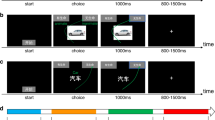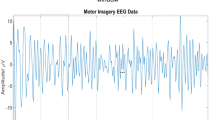Abstract
Brain–computer interface (BCI) technology used to monitor conscious-brain electrical activity via electroencephalogram (EEG) signals has facilitated the detection of human preferences. Recently, great progress has been made in the development of novel paradigms and methods for EEG-based preference detection including attempts to apply BCI research findings in various contexts. Advances in BCI technology have increased the scientists’ interest in possible practical applications of BCI technology involving a human–machine interaction. A major objective of our research was to provide an overview of recent advances in EEG-based preference detection applications. As a foundation for our research, we reviewed previous studies in EEG-based neuromarketing and classified them according to their practical domains, research directions, and recording modalities. Another major research goal was to investigate how the analysis of EEG signals using classification algorithms can be applied to recognize and understand consumers’ mental states and preferences patterns. To this end, we built three different classification algorithms: the random forest (RF), support vector machine (SVM), and the k-nearest neighbor (KNN). Our results demonstrate that RF is more accurate than either KNN or SVM.










Similar content being viewed by others
References
Aldayel, M.; Ykhlef, M.; Al-Nafjan, A.: Deep learning for EEG-based preference classification in neuromarketing. Appl. Sci. 10(4), 1 (2020). https://doi.org/10.3390/app10041525
Ramsøy, T.Z.; Friis-Olivarius, M.; Jacobsen, C.; Jensen, S.B.; Skov, M.: Effects of perceptual uncertainty on arousal and preference across different visual domains. J. Neurosci. Psychol. Econ. 5(4), 212 (2012). https://doi.org/10.1037/a0030198
Daugherty, T.; Hoffman, E.; Kennedy, K.: Research in reverse: Ad testing using an inductive consumer neuroscience approach. J. Bus. Res. 69(8), 3168 (2016). https://doi.org/10.1016/j.jbusres.2015.12.005
Teo, J.; Chew, L.H.; Chia, J.T.; Mountstephens, J.: Classification of affective states via EEG and deep learning. Int. J. Adv. Comput. Sci. Appl. 9(5), 132 (2018)
Khushaba, R.N.; Greenacre, L.; Kodagoda, S.; Louviere, J.; Burke, S.; Dissanayake, G.: Choice modeling and the brain: a study on the Electroencephalogram (EEG) of preferences. Expert Syst. Appl. 39(16), 12378 (2012). https://doi.org/10.1016/j.eswa.2012.04.084
Alvino, L.; Constantinides, E.; Franco, M.: Towards a better understanding of consumer behavior: marginal utility as a parameter in neuromarketing research. Int. J. Mark. Stud. 10(1), 90 (2018). https://doi.org/10.5539/ijms.v10n1p90
Al-Nafjan, A.; Hosny, M.; Al-Ohali, Y.; Al-Wabil, A.: Review and classification of emotion recognition based on EEG brain–computer interface system research: a systematic review. Appl. Sci. 7(12), 1239 (2017). https://doi.org/10.3390/app7121239
Ohme, R.; Reykowska, D.; Wiener, D.; Choromanska, A.: Application of frontal EEG asymmetry to advertising research. J. Econ. Psychol. 31((5, SI)), 785 (2010). https://doi.org/10.1016/j.joep.2010.03.008
Plassmann, H.; Venkatraman, V.; Huettel, S.; Yoon, C.: Consumer neuroscience: applications, challenges, and possible solutions. J. Mark. Res. 52(4), 427 (2015)
Riedl, R.; Léger, P.M.: Fundamentals of NeuroIS: Information Systems and the Brain (2016). https://doi.org/10.1007/978-3-662-45091-8
Dimoka, A.; Pavlou, P.A.; Davis, F.D.: NeuroIS: the potential of cognitive neuroscience for information systems research. Inf. Syst. Res. 22(4), 687 (2011). https://doi.org/10.1287/isre.1100.0284
Agarwal, S.; Dutta, T.: Neuromarketing and consumer neuroscience: current understanding and the way forward. Decision 42(4), 457 (2015). https://doi.org/10.1007/s40622-015-0113-1
Murugappan, M.; Murugappan, S.; Balaganapathy; Gerard, C.: Wireless EEG signals based Neuromarketing system using Fast Fourier Transform (FFT). In: 2014 IEEE 10th International Colloquium on Signal Processing and its Applications Applications, pp. 25–30. IEEE (2014). https://doi.org/10.1109/CSPA.2014.6805714
Lin, M.H.J.; Cross, S.N.N.; Jones, W.J.; Childers, T.L.: Applying EEG in consumer neuroscience. Eur. J. Mark. 52(1–2), 66 (2018). https://doi.org/10.1108/EJM-12-2016-0805
Ma, Q.; Wang, K.; Wang, X.; Wang, C.; Wang, L.: The influence of negative emotion on brand extension as reflected by the change of N2: a preliminary study. Neurosci. Lett. 485(3), 237 (2010). https://doi.org/10.1016/j.neulet.2010.09.020
Wang, X.; Ma, Q.; Wang, C.: N400 as an index of uncontrolled categorization processing in brand extension. Neurosci. Lett. 525(1), 76 (2012). https://doi.org/10.1016/j.neulet.2012.07.043
Jones, W.J.; Childers, T.L.; Jiang, Y.: The shopping brain: math anxiety modulates brain responses to buying decisions. Biol. Psychol. 89(1), 201 (2012). https://doi.org/10.1016/j.biopsycho.2011.10.011
Venkatraman, V.; Dimoka, A.; Pavlou, P.A.; Vo, K.; Hampton, W.; Bollinger, B.; Hershfield, H.; Ishihara, M.; Winer, R.S.: Predicting advertising success beyond traditional measures: new insights from neurophysiological methods and market response modeling. J. Mark. Res. 52(4), 436 (2015). https://doi.org/10.2139/ssrn.2498095
Venkatraman, V.; Clithero, J.A.; Fitzsimons, G.J.; Huettel, S.A.: New scanner data for brand marketers: how neuroscience can help better understand differences in brand preferences. J. Consum. Psychol. 22((1, SI)), 143 (2012). https://doi.org/10.1016/j.jcps.2011.11.008
Hakim, A.; Klorfeld, S.; Sela, T.; Friedman, D.; Shabat-Simon, M.; Levy, D.J.: Pathways to consumers minds: using machine learning and multiple EEG metrics to increase preference prediction above and beyond traditional measurements. bioRxiv (2018). https://doi.org/10.1101/317073
Boksem, M.A.S.; Smidts, A.: Brain responses to movie trailers predict individual preferences for movies and their population-wide commercial success. J. Mark. Res. 52(4), 482 (2015)
Hadjidimitriou, S.K.; Hadjileontiadis, L.J.: Toward an EEG-based recognition of music liking using time-frequency analysis. IEEE Trans. Biomed. Eng. 59(12), 3498 (2012). https://doi.org/10.1109/TBME.2012.2217495
Ait Hammou, K.; Galib, M.H.; Melloul, J.: The contributions of neuromarketing in marketing research. J. Manag. Res. 5(4), 20 (2013). https://doi.org/10.5296/jmr.v5i4.4023
Ohme, R.; Reykowska, D.; Wiener, D.; Choromanska, A.: Analysis of neurophysiological reactions to advertising stimuli by means of EEG and galvanic skin response measures. J. Neurosci. Psychol. Econ. 2(1), 21 (2009). https://doi.org/10.1037/a0015462
Ramadan, R.A.; Refat, S.; Elshahed, M.A.; Ali, R.A.: Brain–computer interfaces, intelligent systems reference library, vol. 74. Springer, Cham (2015). https://doi.org/10.1007/978-3-319-10978-7
Abdulkader, S.N.; Atia, A.; Mostafa, M.S.M.: Brain computer interfacing: applications and challenges. Egypt. Inf. J. 16(2), 213 (2015). https://doi.org/10.1016/j.eij.2015.06.002
Hwang, H.J.; Kim, S.; Choi, S.; Im, C.H.: EEG-based brain–computer interfaces: a thorough literature survey. Int. J. Hum. Comput. Interact. 29(12), 814 (2013). https://doi.org/10.1080/10447318.2013.780869
Zander, T.O.; Kothe, C.: Towards passive brain–computer interfaces: applying brain–computer interface technology to human–machine systems in general. J. Neural Eng. (2011). https://doi.org/10.1088/1741-2560/8/2/025005
Ramadan, R.A.; Vasilakos, A.V.: Brain computer interface: control signals review. Neurocomputing 223(October 2016), 1 (2016). https://doi.org/10.1016/j.neucom.2016.10.024
Bercik, J.; Horska, E.; Wang, R.W.Y.; Chen, Y.C.: The impact of parameters of store illumination on food shopper response. Appetite 106, 101 (2016). https://doi.org/10.1016/j.appet.2016.04.010
Monica, È.B.; Iuliana, C.; Mihai, È.: Studying the user experience in online banking services: an eye-tracking application. Stud. Bus. Econ. 14(2), 193 (2019). https://doi.org/10.2478/sbe-2019-0034
Wang, J.; Han, W.: The impact of perceived quality on online buying decisions: an event-related potentials perspective. Neuroreport 25(14), 1091 (2014). https://doi.org/10.1097/WNR.0000000000000233
Goto, N.; Mushtaq, F.; Shee, D.; Lim, X.L.; Mortazavi, M.; Watabe, M.; Schaefer, A.: Neural signals of selective attention are modulated by subjective preferences and buying decisions in a virtual shopping task. Biol. Psychol. 128, 11 (2017). https://doi.org/10.1016/j.biopsycho.2017.06.004
Yadava, M.; Kumar, P.; Saini, R.; Roy, P.P.; Dogra, D.P.: Analysis of EEG signals and its application to neuromarketing. Multimed. Tools Appl. 76(18), 19087 (2017). https://doi.org/10.1007/s11042-017-4580-6
Touchette, B.; Lee, S.E.: Measuring neural responses to apparel product attractiveness: an application of frontal asymmetry theory. Cloth. Text. Res. J. 35(1), 3 (2017). https://doi.org/10.1177/0887302X16673157
Agarwal, M.; Sivakumar, R.: Cerebro: A Wearable Solution to Detect and Track User Preferences using Brainwaves, pp. 47–52 (2019). https://doi.org/10.1145/3325424.3329660
Vecchiato, G.; Toppi, J.; Astolfi, L.; Fallani, F.D.V.; Cincotti, F.; Mattia, D.; Bez, F.; Babiloni, F.: Spectral EEG frontal asymmetries correlate with the experienced pleasantness of TV commercial advertisements. Med. Biol. Eng. Comput. 49((5, SI)), 579 (2011). https://doi.org/10.1007/s11517-011-0747-x
Vecchiato, G.; Astolfi, L.; Fallani, F.D.V.; Cincotti, F.; Mattia, D.; Salinari, S.; Soranzo, R.; Babiloni, F.: Changes in brain activity during the observation of TV commercials by using EEG, GSR and HR measurements. Brain Topog. 23(2), 165 (2010). https://doi.org/10.1007/s10548-009-0127-0
Cartocci, G.; Caratu, M.; Modica, E.; Maglione, A.G.; Rossi, D.; Cherubino, P.; Babiloni, F.: Electroencephalographic, heart rate, and galvanic skin response assessment for an advertising perception study: application to antismoking public service announcements. J. Vis. Exp. (2017). https://doi.org/10.3791/55872
Telpaz, A.; Webb, R.; Levy, D.J.: Using EEG to Predict Consumers’ Future Choices. J. Mark. Res. 52(4), 511 (2015). https://doi.org/10.1509/jmr.13.0564
Khushaba, R.N.; Wise, C.; Kodagoda, S.; Louviere, J.; Kahn, B.E.; Townsend, C.: Consumer neuroscience: assessing the brain response to marketing stimuli using electroencephalogram (EEG) and eye tracking. Expert Syst. Appl. 40(9), 3803 (2013). https://doi.org/10.1016/j.eswa.2012.12.095
Chew, L.H.; Teo, J.; Mountstephens, J.: Aesthetic preference recognition of 3D shapes using EEG. Cognit. Neurodyn. 10(2), 165 (2016). https://doi.org/10.1007/s11571-015-9363-z
Modica, E.; Cartocci, G.; Rossi, D.; Martinez Levy, A.C.; Cherubino, P.; Maglione, A.G.; Di Flumeri, G.; Mancini, M.; Montanari, M.; Perrotta, D.; Di Feo, P.; Vozzi, A.; Ronca, V.; Aricò, P.; Babiloni, F.: Neurophysiological responses to different product experiences. Comput. Intell. Neurosci. (2018). https://doi.org/10.1155/2018/9616301
Michael, I.; Ramsoy, T.; Stephens, M.; Kotsi, F.: A study of unconscious emotional and cognitive responses to tourism images using a neuroscience method. J. Islam. Mark. 10(2), 543 (2019). https://doi.org/10.1108/JIMA-09-2017-0098
Cherubino, P.: Application of Neuro-marketing techniques to the wine tasting experience. In: 11th Annual Conference of the EuroMed Academy of Business, Malta, pp. 290–298 (2018)
Ramsøy, T.Z.; Skov, M.; Christensen, M.K.; Stahlhut, C.: Frontal brain asymmetry and willingness to pay. Front. Neurosci. (2018). https://doi.org/10.3389/fnins.2018.00138
Ma, Q.; Wang, X.; Shu, L.; Dai, S.: P300 and categorization in brand extension. Neurosci. Lett. 431(1), 57 (2008). https://doi.org/10.1016/j.neulet.2007.11.022
Yang, T.; Lee, S.; Seomoon, E.; Kim, S.P.: Characteristics of human brain activity during the evaluation of service-to-service brand extension. Front. Hum. Neurosci. (2018). https://doi.org/10.3389/fnhum.2018.00044
Bosshard, S.S.; Bourke, J.D.; Kunaharan, S.; Koller, M.; Walla, P.: Established liked versus disliked brands: brain activity, implicit associations and explicit responses. Cogent Psychol. (2016). https://doi.org/10.1080/23311908.2016.1176691
Lee, N.; Chamberlain, L.; Brandes, L.: Welcome to the jungle! The neuromarketing literature through the eyes of a newcomer. Eur. J. Mark. 52(1–2), 4 (2018). https://doi.org/10.1108/EJM-02-2017-0122
Morin, C.: Neuromarketing: the new science of consumer behavior. Society 48(2), 131 (2011). https://doi.org/10.1007/s12115-010-9408-1
Vecchiato, G.; Maglione, A.G.; Cherubino, P.; Wasikowska, B.; Wawrzyniak, A.; Latuszynska, A.; Latuszynska, M.; Nermend, K.; Graziani, I.; Leucci, M.R.; Trettel, A.; Babiloni, F.: Neurophysiological tools to investigate consumer’s gender differences during the observation of TV commercials. Comput. Math. Methods Med. (2014). https://doi.org/10.1155/2014/912981
Stanton, S.J.; Sinnott-Armstrong, W.; Huettel, S.A.: Neuromarketing: ethical implications of its use and potential misuse. J. Bus. Ethics 144(4), 799 (2017). https://doi.org/10.1007/s10551-016-3059-0
Krampe, C.; Gier, N.R.; Kenning, P.: The application of mobile fNIRS in marketing research detecting the first-choice-brand effect. Front. Hum. Neurosci. 12, 433 (2018)
Meyerding, S.G.; Mehlhose, C.M.: Can neuromarketing add value to the traditional marketing research? An exemplary experiment with functional near-infrared spectroscopy (fNIRS). J. Bus. Res. 107, 172 (2020). https://doi.org/10.1016/j.jbusres.2018.10.052
Aldayel, M.S.; Ykhlef, M.; Al-Nafjan, A.N.: Electroencephalogram-based preference prediction using deep transfer learning. IEEE Access 8, 176818 (2020). https://doi.org/10.1109/ACCESS.2020.3027429
Barros, R.Q.; Tavares, A.S.; Albuquerque, W.; da Silva, J.C.; de Lemos, I.A.; de Albuquerque Cardoso, R.L.S.; Soares, M.M.; Cairrao, M.R.: Analysis of product use by means of eye tracking and EEG: a study of neuroergonomics. In: Marcus, A. (eds.) Design, User Experience, and Usability: Novel User Experiences. DUXU 2016. Lecture Notes in Computer Science, vol. 9747, pp. 539–548. Springer, Cham. https://doi.org/10.1007/978-3-319-40355-7_51
Cohrdes, C.; Wrzus, C.; Frisch, S.; Riediger, M.: Tune yourself in: Valence and arousal preferences in music-listening choices from adolescence to old age. Dev. Psychol. 53(9), 1777 (2017). https://doi.org/10.1037/dev0000362
Al-Nafjan, A.; Hosny, M.; Al-Wabil, A.; Al-Ohali, Y.: Classification of human emotions from electroencephalogram (EEG) signal using deep neural network. Int. J. Adv. Comput. Sci. Appl. 8(9), 419 (2017). https://doi.org/10.14569/ijacsa.2017.080955
Aldayel, M.S.: K-Nearest Neighbor classification for glass identification problem. In: 2012 International Conference on Computer Systems and Industrial Informatics, ICCSII 2012 (2012). https://doi.org/10.1109/ICCSII.2012.6454522
Vega-Escobar, L.; Castro-Ospina, A.; Duque-Munoz, L.: DWT-based feature extraction for motor imagery classification. In: 6th Latin-American Conference on Networked and Electronic Media (2016). https://doi.org/10.1049/ic.2015.0309
Moon, J.; Kim, Y.; Lee, H.; Bae, C.; Yoon, W.C.: Extraction of user preference for video stimuli using EEG-based user responses. ETRI J. 35(6), 1105 (2013). https://doi.org/10.4218/etrij.13.0113.0194
Acknowledgements
This research project was supported by a grant from the “Research Center of the Female Scientific and Medical Colleges,” Deanship of Scientific Research, King Saud University.
Author information
Authors and Affiliations
Corresponding author
Rights and permissions
About this article
Cite this article
Aldayel, M., Ykhlef, M. & Al-Nafjan, A. Consumers’ Preference Recognition Based on Brain–Computer Interfaces: Advances, Trends, and Applications. Arab J Sci Eng 46, 8983–8997 (2021). https://doi.org/10.1007/s13369-021-05695-4
Received:
Accepted:
Published:
Issue Date:
DOI: https://doi.org/10.1007/s13369-021-05695-4




